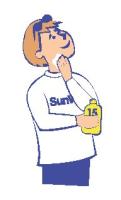Posts Tagged ‘Sunburn’
Treating Sunburn. By Our Student Pharmacist, David Brokaw.
June is one of the most beautiful months of the year in Ohio, and, like most of us, I like to spend as much time as possible outside enjoying the weather. The downside is that every year, without fail, I innocently stay outside all afternoon on the first free sunny day, while totally forgetting that the sun is a giant ball of energy constantly radiating powerful UV light down to Earth. Somehow, being incarcerated indoors all winter long has this incredible amnestic effect on my memory of last year’s sunburn. So again, I learned the hard way about sunburn and the cosmetic appeal (and pain) that comes with a fantastic “farmer’s tan.”
Here are a few things I learned along the way:
Sunburn appears as painful, reddened skin with possible swelling, which is associated with increased blood flow. The worst part of the burn is usually delayed, appearing after 24-48 hours.
Mild sunburn is red, painful, warm to the touch, and may be accompanied by a low grade fever, dizziness, or a headache. The skin may peel after several days as new skin cells are produced from lower layers to regenerate the damaged layer of skin (epidermis).
Moderate sunburns, however, can lead to nausea, fever or chills, and blistering, which may require professional wound care.
Severe sunburns may lead to heat stroke, so patients with fever, confusion, weakness, or convulsions should seek medical attention immediately. Even some of the medications we take can make us burn faster, increasing our photosensitivity, so we should check with our pharmacists if we have a concern.
General treatment for sunburn should start with staying out of the sun and covering up with protective clothing when outside. Cool compresses or a cool bath can help relieve pain. To prevent drying of the skin, a skin cream or ointment can be used to trap moisture. Some choose an aloe vera product to help soothe the skin. Blisters should not be broken open, because they protect the skin underneath, nor should peeling skin be pulled off. Vitamin C plays a major role in wound healing and taking two grams daily could possibly help until the burn is healed.
To treat sunburn symptoms, time heals all wounds–in this case 3-6 days for mild and 2-3 weeks for moderate sunburns. But for pain, we have a couple of options. NSAIDs or non-steroidal anti-inflammatory drugs like ibuprofen (Advil, Motrin), naproxen (Aleve), and aspirin, are preferred to help with the redness and swelling especially in the first 24 hours after UV exposure. These drugs are taken differently from each other, so it is important to read the directions on the label for correct dosing and appropriateness for children. Some people cannot take NSAIDs, so Tylenol is an option there. Provided that you are not allergic, topical anesthetics (benzocaine, lidocaine) should only be used on intact skin (not blisters), and should only be used on small areas of skin, no more than 3-4 times a day.
What shouldn’t you use? Products with menthol or camphor, although they smell nice (think Vick’s VapoRub), should not be used because they can actually increase the pain and swelling. Ouch! Also, the use of honey as a home remedy for sunburn is not recommended by burn centers.
Next time I decide to enjoy time in the sun outside with friends, you’d better believe I will have my sunblock and a good pair of sunglasses with me!
[Source: Dlugosz CK. The Practioner’s Quick Reference to Nonprescription Drugs. Washington, D.C.: American Pharmacists Association. 2009. pp 30-41.]
Walk in the Sunshine, but Don’t Get Burned! By Anna Gehres, Pharmacy Student Extraordinaire.
With the summer sun here to stay for awhile, it is a good time to review sun safety and sunburn treatment. Sunshine is essential for overall health and relaxation. However, too much sun can be harmful. Here are some tips to play it safe in the sun:
- Limit your time in the sun: the sun is strongest between 10am and 4pm.
- If you are outside, wear protective clothing.
- Don’t forget your ears, neck AND eyes!
- Be sure to wear sunscreen.
About that sunscreen…
- Use a sunscreen with at LEAST a sun protection factor (SPF) 15.
- Look for a sunscreen with UVA and UVB protection.
- Most importantly, apply sunscreen!
Apply 30 minutes before going out into the sun.
Reapply every 2 hours during the peak sun hours.
Reapply more often if swimming or sweating.
Avoid sunscreen/bug repellent combinations, as sunscreen needs reapplied.
What to do if you get sunburned?
The best way to treat sunburn is to prevent it! For a minor sunburn (no blisters) take a cool bath or apply a cool water-compress. Sunburn can be painful, but there are pain relief options that can be used. Just ask us at the pharmacy and we will help you find the best product! If the burn is severe (fever, chills, upset stomach, confusion), seek medical attention immediately.
Any questions? Just come on in and ask us!







